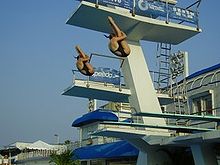Synchronous jumping
The synchronized diving is a form of art and high diving .
technology
Synchronized jumping has been one of the Olympic disciplines as a water sport since 2000 . Two athletes of the same sex each jump from the 3-meter board or the diving tower . Both the individual execution of the individual jumper and the synchronicity of both jumps, which should be completely identical, are evaluated . So-called "counter jumps", forwards and backwards somersaults or Auerbach somersaults and dolphins somersaults , which are performed symmetrically , are no longer permitted in competitions today.
The systematics of the jumping elements and their training are largely identical to the individual art jumping . In addition to the age groups A, B and C youth, there is an Olympic squad. In the competition five jumps are required for women and six for men.
Well-known athletes
Well-known synchronized jumpers are the Russian Dmitri Sautin , who won gold in tower synchronized jumping and silver in jumping from the 3-meter board with various partners at the first competitions at the 2000 Olympic Games , or the Australian Robert Newbery , who won bronze in 2000 and 2004 from 3-meter board won. For women, for example, the Canadian Émilie Heymans , silver 2000 and bronze 2004 from the tower, and the couple Wera Iljina and Julija Pachalina , gold 2000 and silver 2004 from the board. Guo Jingjing won gold from the board after silver in 2000 with another partner in 2004.
Known German Springer are Jan Hempel and Heiko Meyer , who won at the Olympic Games from the tower bronze in 2000, Annett Gamm 2002 and 2004 and 2006 with Nora Subschinski European champions, Ditte Kotzian and Conny Schmalfuß and the men Andreas Wels and Tobias Schellenberg , the won Olympic silver from the three-meter board in 2004.
